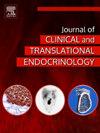Association between incretin-based drugs and risk of cholangiocarcinoma among patients with type 2 diabetes: A large population-based matched cohort study
IF 3.3
Q1 ENDOCRINOLOGY & METABOLISM
Journal of Clinical and Translational Endocrinology
Pub Date : 2024-09-18
DOI:10.1016/j.jcte.2024.100370
引用次数: 0
Abstract
Aim
To examine the association between the use of incretin-based drugs [glucagon-like peptide-1 receptor agonists (GLP-1RAs), dipeptidyl peptidase-4 inhibitors (DPP-4Is)] and the risk of cholangiocarcinoma (CCA) in the United States.
Methods
This large population-based, retrospective cohort study using the TriNetX datasets included adult patients with type 2 diabetes mellitus (T2DM) who were new users of GLP-1RAs, DPP-4Is, or other second- or third-line antidiabetic drugs between 2010 and 2021. The primary outcome was the incidence of CCA.
Results
A total of 3,816,071 patients were included (mean age, 61.4 years, female, 49.3 %). A 51 % and 23 % risk reduction in CCA after 1 year of exposure to GLP-1RAs (hazard ratio 0.49; 95 % CI 0.40–0.60) and DPP4Is (0.77, 95 % CI 0.67–0.90), respectively compared to new second-or third-line users. Results were consistent at 3, 5, and 7 years of follow-up (0.66, 0.71, and 0.72 for GLP-1RAs and 0.84, 0.87, and 0.85 for DPP-4Is, respectively). Compared to new metformin users, GLP-1RA users were associated with a 42 % lower risk of developing CCA, whereas DPP-4I group was not associated with an increased risk.
Conclusions
GLP-1RAs and DPP-4Is were not associated with a significantly increased risk of CCA. GLP-1RAs even showed a reduced risk of CCA development. They can be considered as safe and effective treatment options for patients with T2DM at risk of CCA.
基于增量素的药物与 2 型糖尿病患者罹患胆管癌风险之间的关系:大型人群匹配队列研究
目的研究美国增量素类药物[胰高血糖素样肽-1 受体激动剂 (GLP-1RA)、二肽基肽酶-4 抑制剂 (DPP-4Is)]的使用与胆管癌 (CCA) 风险之间的关系。方法这项基于人群的大型回顾性队列研究使用 TriNetX 数据集,纳入了 2010 年至 2021 年间新使用 GLP-1RAs、DPP-4Is 或其他二线或三线抗糖尿病药物的 2 型糖尿病 (T2DM) 成年患者。结果共纳入 3,816,071 名患者(平均年龄 61.4 岁,女性占 49.3%)。与二线或三线新用户相比,使用 GLP-1RAs(危险比为 0.49;95 % CI 为 0.40-0.60)和 DPP4Is(危险比为 0.77,95 % CI 为 0.67-0.90)1 年后,CCA 风险分别降低了 51 % 和 23 %。随访 3 年、5 年和 7 年的结果一致(GLP-1RAs 分别为 0.66、0.71 和 0.72,DPP-4Is 分别为 0.84、0.87 和 0.85)。与二甲双胍新使用者相比,GLP-1RA 使用者罹患 CCA 的风险降低了 42%,而 DPP-4I 使用者罹患 CCA 的风险并没有增加。结论GLP-1RAs和DPP-4Is与CCA风险的明显增加无关,GLP-1RAs甚至降低了CCA的发病风险。对于有 CCA 风险的 T2DM 患者来说,这两种药物可被视为安全有效的治疗选择。
本文章由计算机程序翻译,如有差异,请以英文原文为准。
求助全文
约1分钟内获得全文
求助全文
来源期刊

Journal of Clinical and Translational Endocrinology
ENDOCRINOLOGY & METABOLISM-
CiteScore
6.10
自引率
0.00%
发文量
24
审稿时长
16 weeks
 求助内容:
求助内容: 应助结果提醒方式:
应助结果提醒方式:


